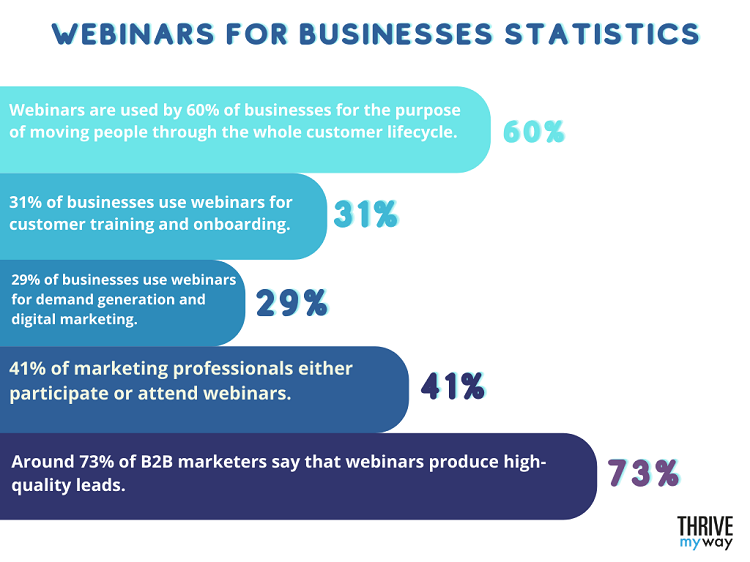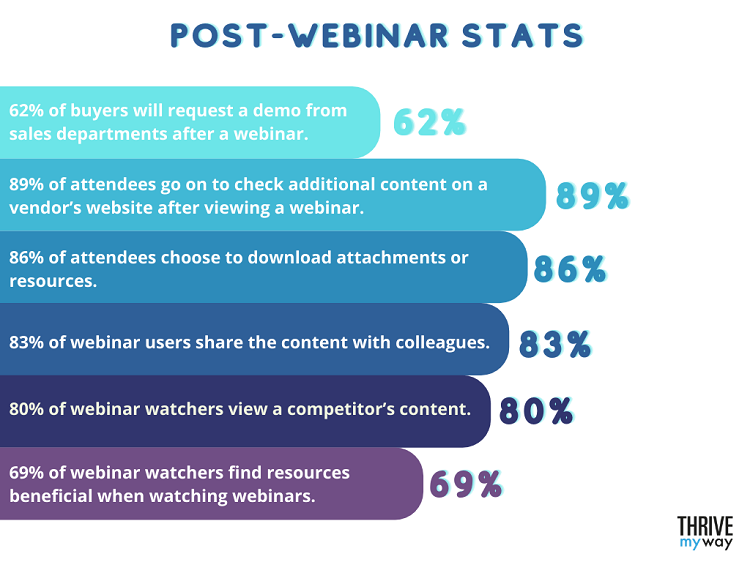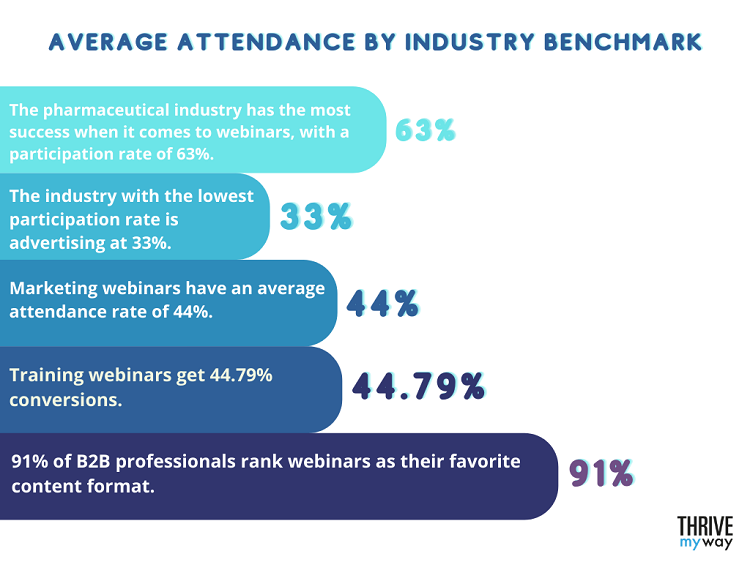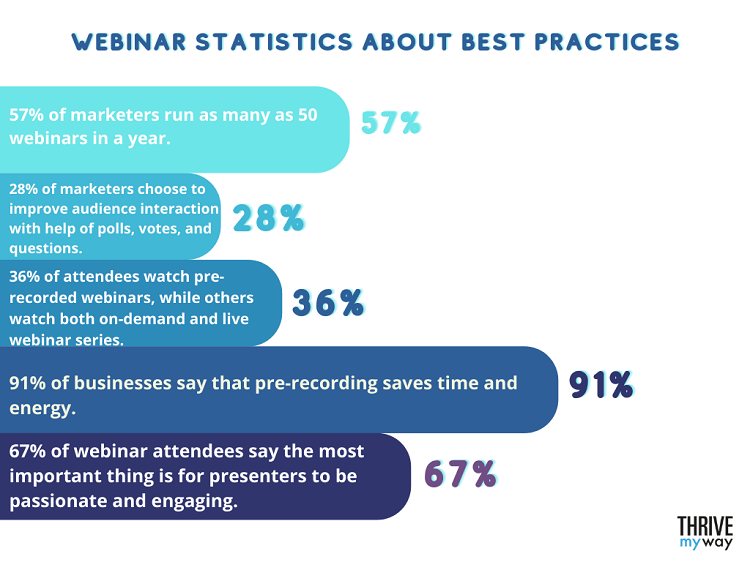Webinars are also known as live classes, online workshops, and virtual training, and they’re a great way to grow your audience as part of your marketing strategy and sales funnel.
They also provide an opportunity to reach a new audience.
You can use many webinar software platforms, and you don’t have to be a technological whizz.
Even a novice can make a webinar easily without breaking the bank.
If you still need convincing, check out the following webinar stats, trends, benchmarks, and facts for 2024.
Table of Contents
ToggleInteresting Webinar Marketing Statistics and Facts 2024
- For 60% of businesses, the aim is to convert users into paying customers, and they design their webinars accordingly.
- More than half of B2B professionals watch webinars every week.
- The best days for hosting a webinar are between Tuesdays and Thursdays.
- According to customers, on-demand viewing is the most valuable addition to a webinar’s features.
- According to 89% of marketers, webinars outperform all other channels when it comes to creating qualified leads.
- Projections are that the webinar market will reach $800 million by 2024, which is a 46.2% increase from the $547 million the market achieved in 2015.
- B2B marketing experts generate from 500 to 1,000 leads per webinar.
- The average duration of a webinar is 39 to 60 minutes.
- Use the following five webinar metrics to determine the success of your event: Attendance, lead generation, audience engagement, and retention, increased brand awareness, and audience feedback.
- Marketers say that webinars are cost-effective because they lower the cost-per-lead.
- Professionals say that video-based learning is the preferred format.
- Viewers watched three times more webinar content in 2020 than they did the previous year.
- 75% of marketers say webinars extend brand reach.
- Host your webinars on your company domain, and they will generate three times more audience participation.
- When visitors were asked what they liked to see most, 22% said it was the host or presenter taking questions from the audience.
- Consumers say they are 27% more likely to sign up for a webinar that teaches them something about a hobby or passion.
- 18% of consumers say they would attend a webinar teaching them something about their industry or career.
- Because of their on-demand nature, the average attendance rate of automated webinars is 65%, which is 31% to 46% higher than the industry average for live webinars.
- When registrants of automated webinars are presented with the choice of joining a session on-demand or choosing a later session that fits their calendars, 74% choose on-demand.
Webinar Registrations Statistics 2024
- The average number of registrants for a webinar is 260.
- On average, you can expect 40% to 50% attendance rates.
- In general, 54% of people sign up at least eight days before an event.
- 46% of registrations take place within one week of the event.
- Emails are the most effective way to promote webinars, and Wednesday is the best day to send promotional emails.
- The response rate for emails sent on a Wednesday is 22%.
- You can expect your webinar attendees to be more engaged if you remember the four U’s: useful, urgent, unique, and ultra-specific.
- If recordings of a webinar are available, you can still expect 47% views up to 10 days after the event.
- 73% of signups come from solicitations through an email account.
- Your company website and blog could deliver up to 15% of registrations.
- You can get up to 15% of registrations through social media platforms such as Facebook, Twitter, and LinkedIn.
- 28% of people watching webinars waited until after the registration period to sign up.
Webinar Attendance Facts and Statistic 2024

- Sending an email to remind participants of your event could increase attendance rates by 20%.
- The best time of the day to send emails promoting your webinars is between 8 am and 12 pm.
- The golden hour for webinar attendance is 9 am, with a 14% success rate.
- Thursdays rank as the most popular day of the week if you want to organize a webinar with 19% attendance.
- The prime time to accommodate viewers from around the world is to start your webinar between 2 and 4 pm in the time zone where you expect most of your audience to be listening.
- 33% of webinar sign-ups occur on the day of the webinar.
- Out of 100 registrants, you can expect an average attendance rate of 40-50%.
Webinars for Businesses Statistics 2024

- Webinars are used by 60% of businesses for the purpose of moving people through the whole customer lifecycle.
- 31% of businesses use webinars for customer training and onboarding.
- 29% of businesses use webinars for demand generation and digital marketing.
- 41% of marketing professionals either participate or attend webinars. However, 83% of them say they are very effective.
- You could double your sign-up rates by offering on-demand webinars rather than the standard format.
- Around 73% of B2B marketers say that webinars produce high-quality leads.
- According to recent surveys, B2B marketing professionals rely on webinars and other virtual events more than B2C marketing experts.
Webinar Consumer Behavior Statistics 2024
- Almost 50% of webinar attendees prefer sessions that last 45 minutes.
- 92% of webinar attendees say they would like live question-and-answer sessions before the webinar ends.
- On average, 40% of webinar listeners pay attention from the beginning to the end.
- If you give attendees the option to download presentation slides, 50% of your audience will take advantage.
- 25% of webinar attendees use their mobile phones.
- On average, between 2% and 5% of attendees will go on to buy from your business.
- 78% of buyers will be put off if your webinar is too salesy or marketing-focused.
- 32% of attendees say they feel more engaged when the host is passionate.
Post-Webinar Stats

- 62% of buyers will request a demo from sales departments after a webinar.
- 89% of attendees go on to check additional content on a vendor’s website after viewing a webinar.
- 86% of attendees choose to download attachments or resources.
- 83% of webinar users share the content with colleagues.
- 80% of webinar watchers view a competitor’s content.
- Post-webinar feedback is essential for hosts, so make sure you follow up with attendees.
- 69% of webinar watchers find resources beneficial when watching webinars.
Webinar Production by Industry Benchmark
- In 2019, 29% of all webinars were hosted by software, technology, and SAAS companies.
- 1% of all webinars are produced by non-profit organizations.
- Industries like travel, tourism, and real estate produce just 2% of webinar content.
- Webinars are prevalent across a wide variety of industries but are particular favorites within the B2B space.
- 52% of B2B marketing professionals incorporate webinars into their content marketing strategy.
- 49% of B2B buyers engage with video content before buying.
- 67% of webinar marketers have chosen to increase their webinar investment since the coronavirus outbreak.
- Financial services produce 12% of webinars.
- Consulting services produce 11%.
Average Attendance by Industry Benchmark

- The pharmaceutical industry has the most success when it comes to webinars, with a participation rate of 63%.
- The industry with the lowest participation rate is advertising at 33%.
- Marketing webinars have an average attendance rate of 44%.
- Training webinars get 44.79% conversions.
- 91% of B2B professionals rank webinars as their favorite content format.
Webinar Statistics for Costs and Spending

- On average, a webinar platform plan can cost between $150 and $500 per month if you use a company to host your webinars.
- Apart from software, hosting a webinar requires only three things: A good microphone ($50 to $250), a top-quality webcam ($100 to $200), and lights ($30 to $100).
- The average cost of a webinar ranges from $1,000 to $3,000.
- Webinar data can cost as little as $100 to make and distribute.
- Free software is available if you want to host webinars, but you probably won’t get the results you’re hoping for.
Webinar Conversion Rate Statistics
- The highest conversion rates among all job levels are from practitioners (people actively engaged in an art, discipline, or profession, especially medicine).
- Communication webinars come out on top regarding conversion rates at 67.05%.
- The lowest registrant-to-attendee conversion rate is 30.79% for education-oriented webinars.
- If your webinar takes place in the morning, it will be 93% more successful.
- Only 34% of webinars use polls.
- People tend to only commit to one webinar each week.
Webinar Content Statistics
- A webinar that lasts 60 minutes will attract more viewers than shorter webinars that last 30 minutes or less.
- 81% of webinars include time for a Q&A section.
- 28% of marketers consider simplicity and ease of use as vital for customer engagement.
- Live broadcasts are the preferred webinar session, with 59% of webinar watch ratings.
- Webinar trends indicate that 79% of webinar data is video.
- If the sign-up process is complex, it will lower the number of registrants.
- 34% of attendees show an interest in polls while watching a webinar.
- Aside from the host’s energy and interest, other crucial elements include the use of visuals (15%) and the content’s relevance to the topic (38%).
- 56% of hosts broadcast live video and make it available for on-demand viewing.
Webinar Statistics About Best Practices

- 57% of marketers run as many as 50 webinars in a year.
- To help them stand out from the crowd, 28% of marketers choose to improve audience interaction with the help of polls, votes, and questions.
- 36% of attendees watch pre-recorded webinars, while 5% watch both on-demand and live webinar series.
- 91% of businesses say that pre-recording saves time and energy.
- 67% of webinar attendees say the most important thing is for presenters to be passionate and engaging.
- Creativity and uniqueness have a considerable impact on the number of webinar leads.
Webinar Software Statistics
- 80% of webinar attendees prefer to watch using a Windows operating system, while 18% use Apple devices and only 2% are on Android devices.
- 45% of people watching webinars use Edge or Internet Explorer, and 39% use Google Chrome.
- 33% of marketers make interactive tools a priority when hosting webinars.
- 74% of people will use a designated webinar hosting software tool rather than Vimeo or YouTube, which are more general video-sharing platforms.
- 91% of people prefer to watch webinars on a desktop.
- 50% of webinar hosts use a webcam and webinar software beforehand for recording their webinars.
Webinar Promotion Statistics
- 45% of marketers choose to use emails for promoting their webinars.
- 65% of entrepreneurs decide to promote their webinars by sending an email.
- If you promote your webinar four weeks in advance, you can expect 12% more registrations.
- The most highly rated form of webinar title is a list, for example, 10 Little Known Ways to [blank].
- The second most popular form is the “how-to” structure.
- If you host a webinar on weekends, you might only get 3% of invitees that attend.
- Not promoting your webinar early and often enough is one of the most common pitfalls.
- Automated webinars often do not perform as well as live webinars.
- The top-performing data science webinar is Data Science vs. Data Engineering – Can you really separate them? With 4500 attendees.
You might be interested to check those related posts as well:
- 155 Essential eCommerce Statistics 2024 [Facts and Trends]
- 99+ Useful SaaS Stats 2024 [Facts and Trends]
- 40+ Useful Live Chat Stats 2024 [Facts and Trends]
FAQs
What is the average attendance rate for a webinar?
The average attendance rate is 40%. Although some research suggests that the average attendance rate for a webinar can range from 15-50%, this number can be higher or lower depending on the topic, quality of presentation, and other factors.
What is a good webinar attendance rate?
A general rule of thumb is that you can expect between 35% and 45% of people registered for your online event to turn up to the live version.
What is a good conversion rate for a webinar?
A good conversion rate to aim for is between 20 and 40% of webinar attendees becoming qualified leads.
How many people usually attend a webinar?
The average number of attendees is 148, which means you’ll need to get 500 people to register to be able to expect that number to actually participate.
Final Thoughts
Hosting a webinar brings many benefits, for example:
- Location independence: they are an excellent remote alternative to in-person events.
- Scalability: you can simultaneously speak directly to hundreds, possibly thousands of people.
- Variety: the only limit is your knowledge and imagination.
- Real-time feedback: viewers can type in questions and comments as soon as your webinar is underway.
- Audience attention: viewers typically pay close attention just in case they miss something.
- Trust: you’re giving your business a human face, which helps forge stronger bonds with your audience.
- Leads: webinars are an incredible source of new leads.
The statistics in our list show what a powerful tool webinar can be. Not only are they popular with audiences, but they also generate leads, have a high conversion rate, and deliver a significant ROI.
The figures also show you that you need to put in some effort in planning and promoting your webinars because a haphazard approach just won’t work. Statistical analysis and research also have a part to play.
We used a variety of statistical methods and took inspiration for this post from several different resources. The list includes:
- eWebinar
- Findstack
- 99firms
- Cloud Income
- GoTo
- BloggingX
- RingCentral
- Webinar Care
- Medium
- Letterly.ly



